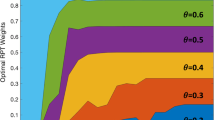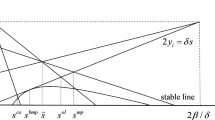Abstract
The aim of this article is to propose an effective technique for solving constraint matrix games with rough interval payoffs, which are a class of non-cooperative two-person matrix games with rough interval payoffs and the strategies of the players are constrained. Since the payoffs of the rough constraint matrix games are rough intervals, then its game value is also a rough interval. In this technique, we derived four linear programming problems, which are used to obtain the upper–lower bound, lower–lower bound, lower–upper bound and upper–upper bound of the rough interval game values of the players in rough constraint matrix games. Moreover, the expected value operator and trust measure of rough interval have been used to obtain the α-trust equilibrium strategies and the expected equilibrium strategies of the problem under study. In addition, the different advantages of the proposed technique over those existing are discussed. Finally, a numerical experiment of market share game model is given and solved by the three mentioned methods to illustrate the effectiveness and practicality of the proposed method.
Similar content being viewed by others
References
Arabani M, Lashteh Nashaei MA (2006) Application of rough set theory as a new approach to simplify dams location. Sci Iranica 13(2):152–158
Bhaumik A, Roy SK, Li D-F (2017) Analysis of triangular intuitionistic fuzzy matrix games using robust ranking. J Intell Fuzzy Syst 33(1):327–336
Das CB, Roy SK (2010) Fuzzy based Ga for entropy bimatrix goal game. Int J Uncertain Fuzziness Knowl Based Syst 18(6):779–799
Das CB, Roy SK (2013) Fuzzy based GA to multi-objective entropy bimatrix game. OPSEARCH 50(1):125–140
Deng X, Jiang W, Zhang J (2017) Zero-sum matrix game with payoffs of Dempster–Shafer belief structures and its applications on sensors. Sensors (Basel Switzerland) 17(4):922
Dubois D, Prade H (2016) Bridging gaps between several forms of granular computing. Granul Comput 1:115–126
Fei W, Li D-F (2016) Bilinear programming approach to solve interval bimatrix games in tourism planning management. Int J Fuzzy Syst 18(3):504–510
Gao J (2013) Uncertain bimatrix game with applications. Fuzzy Optim Decis Making 12:65–78
Hung IC, Hsia KH, Chen LW (1996) Fuzzy differential game of guarding a movable territory. Inf Sci 91:113–131
Li D, Cheng C (2002) Fuzzy multiobjective programming methods for fuzzy constrained matrix games with fuzzy numbers. Int J Uncertain Fuzziness Knowl Based Syst 10(4):385–400
Li D-f, Hong F-x (2013) Alfa-cut based linear programming methodology for constrained matrix games with payoffs of trapezoidal fuzzy numbers. Fuzzy Optim Decis Making 12:191–213
Liu B (2002) Theory and practice of uncertain programming. Physica-Verlag, Heidelberg
Loia V, D’Aniello G, Gaeta A, Orciuoli F (2016) Enforcing situation awareness with granular computing: a systematic overview and new perspectives. Granul Comput 1:127–143
Lu H, Huang G, He L (2011) An inexact rough-interval fuzzy linear programming method for generating conjunctive water-allocation strategies to agricultural irrigation systems. Appl Math Model 35:4330–4340
Mula P, Roy SK, Li D-f (2015) Birough programming approach for solving bi-matrix games with birough payoff elements. J Intell Fuzzy Syst 29:863–875
Nan J-X, Li D-F (2014) Linear programming technique for solving interval-valued constraint matrix games. J Ind Manag Optim 10(4):1059–1070
Nasiri JH, Mashinchi M (2009) Rough set and data analysis in decision tables. J Uncertain Syst 3(3):232–240
Owen G (1982) Game theory, 2nd edn. Academic Press, New York
Pawlak Z (1982) Rough sets. Int J Comput Inf Sci 11(5):341–356
Pawlak Z, Skowron A (2007) Rudiment of rough sets. Inf Sci 177(1):3–27
Pedrycz W, Chen SM (2011) Germany granular computing and intelligent systems: design with information granules of high order and high type. Springer, Heidelberg
Pedrycz W, Chen SM (2015a) Germany granular computing and decision-making: interactive and iterative approaches. Springer, Heidelberg
Pedrycz W, Chen SM (2015b) Germany information granularity, big data, and computational intelligence. Springer, Heidelberg
Peters G, Weber R (2016) DCC: a framework for dynamic granular clustering. Granul Comput 1:1–11
Roy SK (2015) Rough set approach to bi-matrix game. Int J Oper Res 23(2):229–244
Roy SK, Mondal SN (2016) An approach to solve fuzzy interval valued matrix game. Int J Oper Res 26(3):253–267
Roy SK, Mula P (2016) Solving matrix game with rough payoffs using genetic algorithm. Oper Res Int J 16(1):117–130
Skowron A, Jankowski A, Dutta S (2016) Interactive granular computing. Granul Comput 1:95–113
Von Neumann J, Morgenstern D (1944) The theory of games in economic behavior. Wiley, New York
Weigou Y, Mingyu L, Zhi L (2012) Variable precision rough set based decision tree classifier. J Intell Fuzzy Syst 23(2):61–70
Xiao S, Lai EMK (2008) Rough programming approach to power-balanced instruction scheduling for VLIW digital signal processors. IEEE Trans Signal Process 56(4):1698–1709
Xu Z, Wang H (2016) Managing multi-granularity linguistic information in qualitative group decision making: an overview. Granul Comput 1(1):21–35
Yao Y (2016) A Triarchic theory of granular computing. Granul Comput 1:145–157
Acknowledgements
The authors would like to thank the editor and the anonymous reviewers for their helpful comments for revising the article.
Author information
Authors and Affiliations
Corresponding author
Additional information
Publisher’s Note
Springer Nature remains neutral with regard to jurisdictional claims in published maps and institutional affiliations.
Rights and permissions
About this article
Cite this article
Ammar, ES., Brikaa, M.G. On solution of constraint matrix games under rough interval approach. Granul. Comput. 4, 601–614 (2019). https://doi.org/10.1007/s41066-018-0123-4
Received:
Accepted:
Published:
Issue Date:
DOI: https://doi.org/10.1007/s41066-018-0123-4




